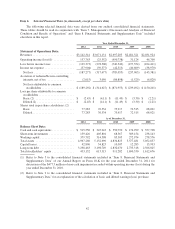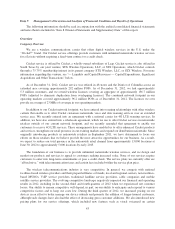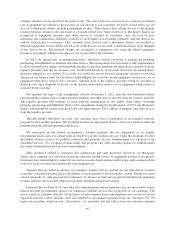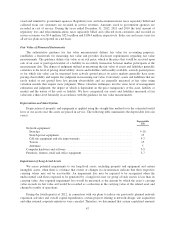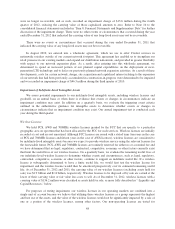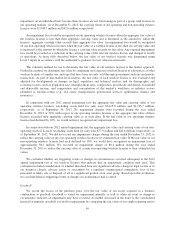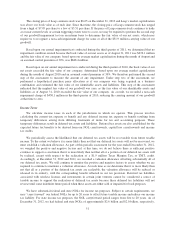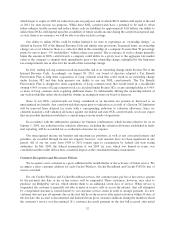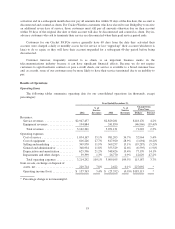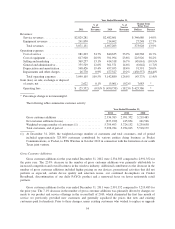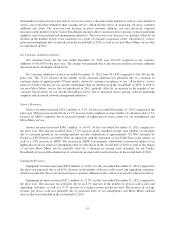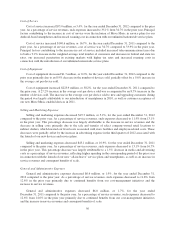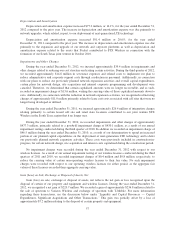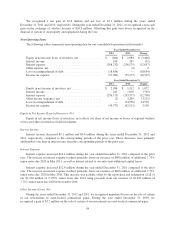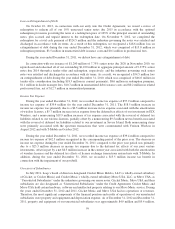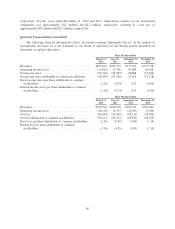Cricket Wireless 2012 Annual Report Download - page 64
Download and view the complete annual report
Please find page 64 of the 2012 Cricket Wireless annual report below. You can navigate through the pages in the report by either clicking on the pages listed below, or by using the keyword search tool below to find specific information within the annual report.our carrying amount to determine if there is a potential goodwill impairment. If the fair value of the reporting
unit is less than its carrying value, an impairment loss is recorded to the extent that the implied fair value of the
goodwill of the reporting unit is less than its carrying value.
During the third quarter of each year, we assess our goodwill for impairment at the reporting unit level by
applying a fair value test. This fair value test involves a two-step process. The first step is to compare the
carrying value of our net assets to our fair value. If the fair value is determined to be less than the carrying value,
a second step is performed to measure the amount of the impairment, if any.
Significant judgments are required in connection with the annual impairment test in order to estimate our
fair value. We have generally based our determination of fair value primarily upon our average market
capitalization for the month of August, plus a control premium. Average market capitalization is calculated based
upon the average number of shares of Leap common stock outstanding during such month and the average
closing price of Leap common stock during such month. We considered the month of August to be an appropriate
period over which to measure average market capitalization in 2012 because trading prices during that period
reflected market reaction to our most recently announced financial and operating results, announced early in the
month of August.
In conducting the annual impairment test during the third quarter of 2012, we applied a control premium of
30% to our average market capitalization. We believe that consideration of a control premium is customary in
determining fair value and is contemplated by the applicable accounting guidance. We believe that our
consideration of a control premium was appropriate because we believe that our market capitalization does not
fully capture the fair value of our business as a whole or the additional amount an assumed purchaser would pay
to obtain a controlling interest in our company. We determined the amount of the control premium as part of our
third quarter 2012 testing based upon relevant transactional experience and an assessment of market, economic
and other factors. Depending on the circumstances, the actual amount of any control premium realized in any
transaction involving our company could be higher or lower than the control premium that we applied.
The carrying value of our goodwill was $31.9 million as of August 31, 2012. Based upon our annual
impairment test conducted during the third quarter of 2012, the value of our net assets as of August 31, 2012 was
$527.5 million and the fair value of our company, based upon our average market capitalization during the month
of August and an assumed control premium of 30%, was $573.5 million. As such, we determined that no
impairment condition existed and we were not required to perform the second step of the goodwill impairment
test.
In the fourth quarter of 2012, we evaluated whether any triggering events or changes in circumstances had
occurred subsequent to the annual impairment test conducted in the third quarter of 2012. As part of this
evaluation, we considered whether there had been any events or circumstances that would indicate it was more
likely than not that our carrying value exceeded our fair value. Based on this evaluation, we determined that the
$106.4 million gain resulting from the spectrum swap with T-Mobile, which closed on October 1, 2012,
constituted a triggering event due to the significant increase in our carrying value that resulted from the
transaction. See “-Liquidity and Capital Resources — Capital Expenditures, Significant Acquisitions and Other
Transactions” below for additional information on the spectrum swap. As such, we were required to perform an
interim goodwill impairment test. In conducting the interim impairment test, we determined our fair value by
using the average market capitalization during the month of October, which was selected because that was the
month in which the spectrum swap transaction closed. Consistent with our annual impairment test conducted in
the third quarter, we continued to apply a control premium of 30% to our average market capitalization. The
carrying value of our goodwill was $31.9 million as of October 31, 2012. The value of our net assets as of
October 31, 2012 was $528.0 million and our fair value, based upon the average market capitalization during the
month of October and an assumed control premium of 30%, was $621.2 million. As such, we determined that no
impairment condition existed on an interim basis and we were not required to perform the second step of the
goodwill impairment test.
50




